Cosmetic Dentistry
Do you often hide your smile behind your hand? Do unsightly gap, yellow teeth or receding gums prohibits you from smiling? Don’t despair! Cosmetic dentistry can give you a better smile, whether your teeth are stained, worn, broken, chipped, misaligned or have a diastema (space between the teeth), cosmetic dentistry can correct them all. With cosmetic dentistry, you have several options to improve your smile.
How is Cosmetic dentistry different from General Dentistry?
Cosmetic dentistry, primarily, aims on improving the aesthetics of your smile, whereas, general dentistry focuses on treating oral diseases and disorders. As the dentistry has evolved, technology has made cosmetic procedures more effective and less time consuming. For instance, cosmetic dentistry has introduced anesthetic free laser treatments and gum treatments, making the procedure pain and anxiety free. Most common types of cosmetic procedures include:
- Dental implant
- Teeth whitening
- Porcelain veneers
- Dental crown
- Dental bridge
- Inlays & Onlays
- Dental braces
- Aligners
Dental Implant
Dental implant is an artificial tooth root made up of titanium. It is embedded into the jawbone to provide support to the artificial teeth. An implant is a permanent solution for missing teeth as it gets fused to the jawbone which doesn’t allow it to slip in the mouth. Dental implant is the closest thing to the natural tooth available in modern dentistry.

Requirement
If you have less bone mass and diseased gums, you may not be a candidate for dental implants. Adequate bone and healthy gums are the most important requirement for dental implant success.
Procedure
The first step of this procedure is to develop a treatment plan. During this planning stage, dentists will examine the mouth. This may involve taking of an impression or an X-ray. Then comes surgical phase; it is performed while the patient is sedated. Dental Implant is placed surgically into the jawbone where it fuses to the bone and serves as an anchor for the replaced tooth. Once the implant is placed in the jawbone, bone formation starts. This process can take from 6-12 weeks. During this phase, a temporary crown can be made to replace missing teeth for aesthetic purposes. Over a period of time implant fuses with the bone and once it’s healed, temporary crown is replaced by a permanent crown. However, the process of dental implants varies a little depending on its types. There are two types of implants:
Endosteal implant
These are also known as traditional implant. Endosteal implant is inserted directly into the jawbone for maximum stability. It requires a healthy jawbone to fuse to.
Subperiosteal implant
These are placed on top of jaw with metal framework post protruding through the gums to hold prosthesis. These are done in cases with minimal bone height.
Alternative Dental Implant Technique
ALL-ON-4 Implants: It allows rehabilitation of totally edentulous patients with the placement of only 4 titanium implants. The implants of ALL-ON-4 procedure are placed at an angle, which allows for increased contact by using the natural support of bone. In this procedure 4 implants are inserted into each jaw. A temporary prosthesis is placed on the same day. During this period, patient has to follow a soft diet while the tissue is still healing and implant bonds with the bone. After a period of time temporary prosthesis is replaced by permanent prosthesis. ALL-ON-4 dental implant saves time and money.
Aftercare
New implant tooth require the same care as a natural tooth. Routine maintenance care at home and follow up at dental office is necessary. With proper care and frequent visit to dentist, dental implant can last a lifetime. Good oral hygiene should also be maintained. Rinsing with mouthwash should be done for at least initial 2 weeks.
Benefits
Dental implants have many advantages that make them a good choice, such as:
- Improved appearance
- Improved chewing ability
- Prevent bone loss
- Prevent further deterioration of facial structure.
- They are not susceptible to dental caries
- Dental implants can last a lifetime
- Restore self esteem
Risks
Since dental implants are surgically placed, they do carry some degree of risk. Risk associated with dental implants are:
- Failure of dental implant to adhere with the bone
- Infection around surrounding bone
- Risk of fracture is increased in smokers
- Dental implant can develop a condition called peri-implantitis (inflammation of mucosa or bone around the implant).
Success rate
Dental implants have high success rate. Out of all cosmetic dentistry procedures, none can match the success rate of dental implants. Clinical studies indicate that dental implant treatment has a success rate of 98%. Success rate of dental implant vary from person to person. Factors that determine the survival rate of implants are age, bone quality, implant length, implant diameter. Dental implant may fail for a number of reasons including smoking, poor oral hygiene, infection and diet.
Tooth Whitening
This technique is used to remove the stains and to improve the color of the teeth, using hydrogen peroxide. Stains and discolorations resulting from tobacco, coffee and tea can be reduced with this simple procedure.
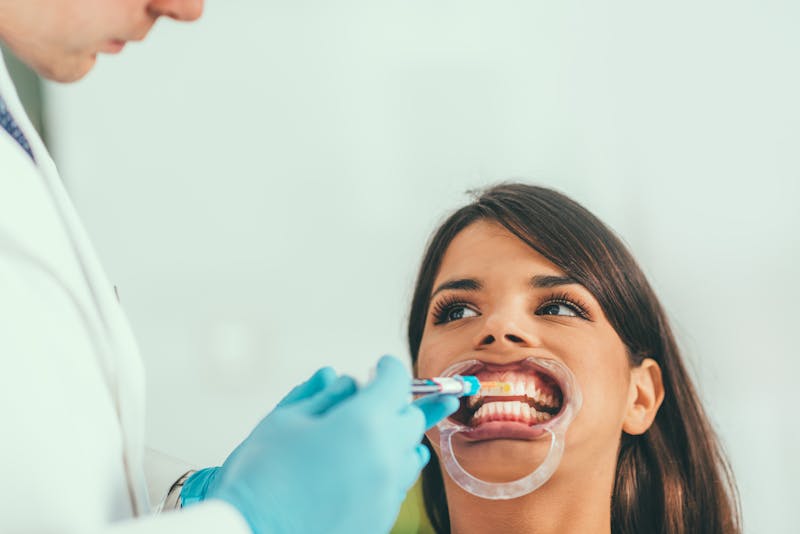
Procedure
First, rubber dam is placed to protect the gums and then whitening solution is applied to the teeth. Next, light is shone on the teeth to accelerate and activate the chemical. This procedure is repeated until desired result is achieved.
Benefits
The benefits of teeth whitening are:
- It enhances the appearance
- It provides results that last a long time
- It is very safe, quick and comfortable option
- It is very affordable procedure
- It improves oral health
Dental Veneers
Dental veneers are thin, custom-made shells of tooth-colored materials designed to cover the front surface of the tooth. It improves the aesthetics of a smile and provides solution for stained, chipped and crooked tooth.
Types of veneers:
Composite veneer
Composite material is applied to the front surfaces of the teeth and is modeled to the correct shape, form and length. They can be used to fix minor chips and cracks in teeth. They are different from porcelain veneers in a way that they require little, if any, tooth reduction and require only one visit.
Disadvantages of composite veneers-
- They are more prone to staining
- They are not as durable as porcelain veneers
Porcelain veneers
Porcelain veneers are fabricated in a dental laboratory and therefore require at least two visits. They are durable and can last for many years.
Disadvantages of porcelain veneers-
- They are more expensive than composite veneers
- They cannot be repaired, whereas composite veneers can be repaired.
Procedure
To prepare the tooth, your dentist will remove a small amount of enamel from the front and sides of the teeth. Next, they will choose the color of porcelain shade based on the color of your teeth. An impression of prepared tooth and its surrounding is made and sent to the laboratory where it will be custom crafted. In the meantime, dentist will provide a temporary veneer to the patient. During a second appointment, the dentist will remove the temporary veneer and will place the new veneer on the teeth to check the accuracy. After all adjustments, the veneers are securely bonded to the tooth.

Aftercare
It is important to follow aftercare instructions, such as:
- Avoid biting on hard objects
- Brush & floss regularly
- Avoid eating food that stains the teeth
Advantages
Some of the advantages of Dental Veneers are:
- Veneers are stain resistant.
- They are strong and durable.
- They provide a natural tooth appearance.
Disadvantages
- They are non repairable
- Porcelain veneers are more expensive than composite veneers
- Sensitivity: Because enamel has been removed, tooth may become more sensitive to hot and cold foods and beverages
Dental Crown
Dental crown is also known as a dental cap. A crown is a hard covering that fits over the entire surface of the tooth. Crown restores the tooth to its normal size, shape and function.
Purpose of dental crown
Crowns are very effective when it comes to:
- Cover misshapen or severely discolored tooth
- Cover a dental implant
- Cover spaces in between teeth
- Protect a tooth that is cracked or worn down.
Types of crown available
There are 4 types of crown available based on their composition and these are:
- Metal alloys
- Ceramic
- Porcelain fused to metal
- Gold alloys
Procedure
First, the dentist will prepare the tooth by removing a layer of outer surface of the tooth. This is done so that the crown fits properly. Then, impression of the prepared tooth is taken and is sent to a dental lab where the crown will be manufactured. This usually takes less than 2 weeks. During this time period patient will be given a temporary crown until the permanent crown is made. At the second visit, permanent crown is cemented. Before cementing the crown, dentist will make sure that it fits well and looks good.
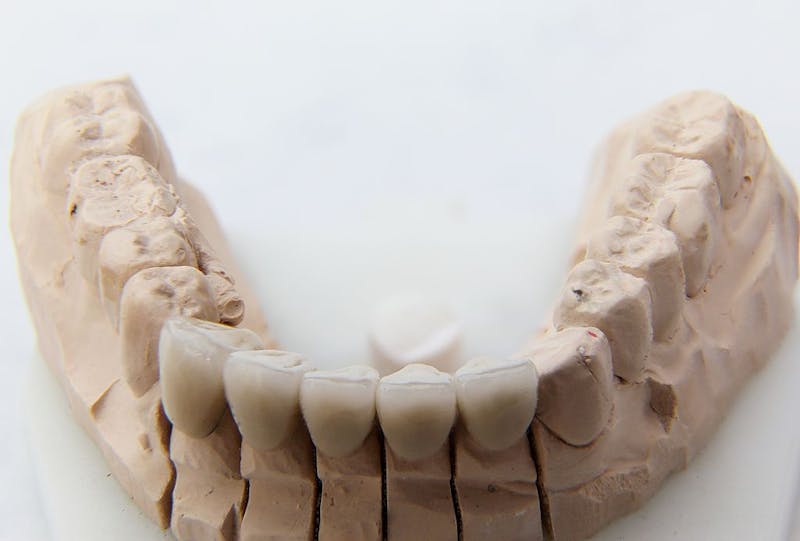
Aftercare
It is extremely important to maintain excellent oral hygiene with new crown.
- Avoid chewing on hard objects
- Avoid sticky food.
Advantages
- Studies have shown that crowns last longer than any other type of dental restoration, including all types of filling and implants.
- Crowns are made up of biocompatible material, so there is no risk of allergic reactions and gum irritation.
- They provide the best possible protection to a heavily broken down tooth.
Disadvantages
- A possible disadvantage to dental crown is that crowned tooth may become sensitive.
- Overtime, the crown can become loose and dislodged.
- If the crown is not sealed properly, bacteria can accumulate and damage the tooth.
Dental Bridge
Dental bridge is a great way to replace a missing tooth. Dental bridge is a prosthesis (false tooth) that is held in place by adjacent teeth on either side of the gap. Dental bridge may be either fixed or removable. The false tooth is called “pontic” and the healthy adjacent teeth that provide support are called “abutment”.
Procedure
First, the abutment teeth are prepared to create enough space for the crown to fit over. Next, impressions of the teeth are made and are sent to a lab to make a customized bridge that fits correctly. Dentist will make a temporary bridge for the patient until the permanent bridge is ready. During the second visit, temporary bridge will be removed and the new permanent bridge will be checked and adjusted, as necessary, to achieve a proper fit.
Aftercare
It is extremely important to maintain excellent oral hygiene with new bridge. Aside from proper hygiene, it is best to avoid excessive pressure on the teeth. Certain habits such as nail biting, chewing pen caps can cause bridge to break so it should be avoided.
Benefits
Dental bridges have following benefits:
- Improves the ability to eat.
- Replaces the missing teeth.
- Prevents the remaining teeth from shifting.
Risks
Dental Bridge provides strong support for teeth replacement. However, several risks and complications are associated with dental bridge. These risks include:
- Allergic reaction to the materials used in the crown. vAn ill fitting bridge can cause decay of the tooth under the crown.
- Patients with dental bridge are at higher risk for gum disease.
Inlays and Onlays
Dental inlays and onlays are restorations that are used to repair teeth that have mild to moderate tooth decay or other damage. Inlays and onlays are fabricated indirectly in a dental lab and are then fitted and bonded to the damaged tooth. Inlay is used when there is decay within the cusps of the teeth, whereas, onlay covers the entire chewing surface including one or more tooth cusps.
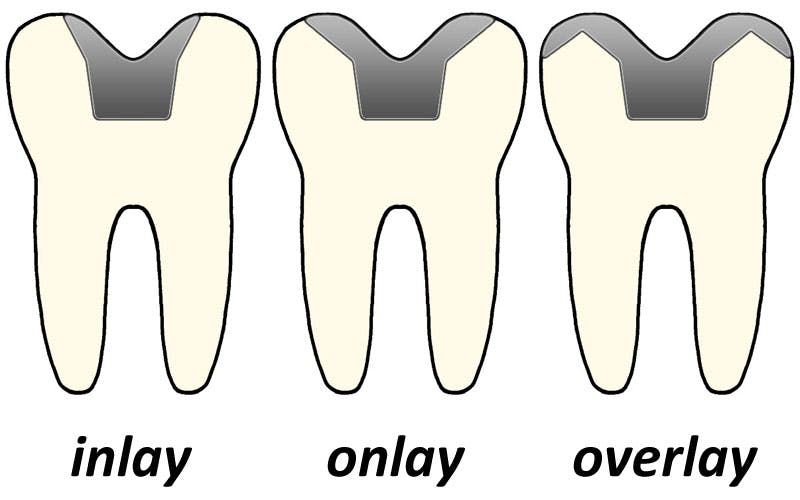
Procedure
Inlays and onlays are prepared using same procedure and both require two dental visits. During the first appointment, dentist begins the procedure by preparing the tooth which involves the removal of the decayed or damaged portion. The area is numbed by local anesthesia before being removed. Next, impression of the tooth is taken and sent to a dental laboratory, where the restoration is fabricated. Inlays and onlays can be made from porcelain, gold or resin materials. The materials work the same way but have a different appearances. A temporary restoration can be created to protect the tooth while the final restoration is being fabricated.
During the second visit, temporary restoration is removed and permanent inlay or onlay is placed to ensure a correct fit. Once fitted, the restoration is permanently attached to the tooth using special cement and then polished to ensure a smooth and aesthetically pleasing finish.
Benefits
Benefits of inlay and onlay includes:
- They don’t involve the removal of healthy tooth structure.
- They are resistant to stains and tooth discoloration.
- They are strong and durable.
- Inlays and onlays prolong tooth life.
Disadvantages
As is the case with most dental procedures; there are also certain disadvantages of inlays and onlays. These include:
- Tooth sensitivity after undergoing dental treatment.
- Bacterial infection
- Multiple dental visits
Braces
Dental braces are appliance used to fix misaligned teeth. They are often used to correct crooked, crowded or protruding teeth.
Benefits
Correcting the problem can create a nice-looking smile. Not correcting an abnormal bite could result in further oral health problems. Below are the essential reasons why braces are necessary:
- The crucial benefit of braces is that they fill the gap present in between the teeth.
- They help to correct crooked teeth.
- To correct misaligned jaws- In some cases, the teeth are straight but jaws are misaligned.
Types of braces
The most common types of braces are:
Metal braces
Metal braces commonly known as traditional braces consist of metal brackets and metal wire. Metal brackets are cemented to the front surface of teeth and metal wire is threaded through the brackets. These are least expensive and are very comfortable.
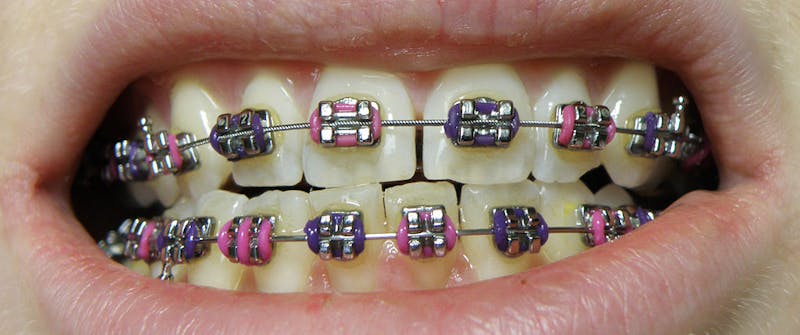
Pros:
- They offer a reliable and economic treatment option.
- They are smaller, lighter and very comfortable to wear
Cons:
- They are most noticeable of all types of braces.
Ceramic braces
Ceramic braces are very popular. This is because the brackets are made up of translucent material. They function exactly like metal braces.
Pros:
- They are less visible than metal braces.
- They offer a faster treatment.
Cons:
- They need high maintenance.
- The bracket could easily stain
- They are less durable
- They are expensive compared to metal braces.
Aligners
Aligners, also known as clear braces are an alternative to traditional braces that uses a series of invisible braces, to straighten and align teeth. It is one of the most popular orthodontic treatments for adults and is precisely manufactured to fit snugly over the teeth. It is designed for mild to moderate cases which includes crooked teeth, overly crowded teeth, forward or backward tilted teeth. Aligners, like other types of teeth braces, work by gradually shifting teeth into the ideal position, making your teeth straight. The only difference is that the aligners are not affixed to the teeth like the metal brackets are. Aligners are not for everyone. Patients with severe crowding or bite issues may not be suitable candidates for invisible aligners.
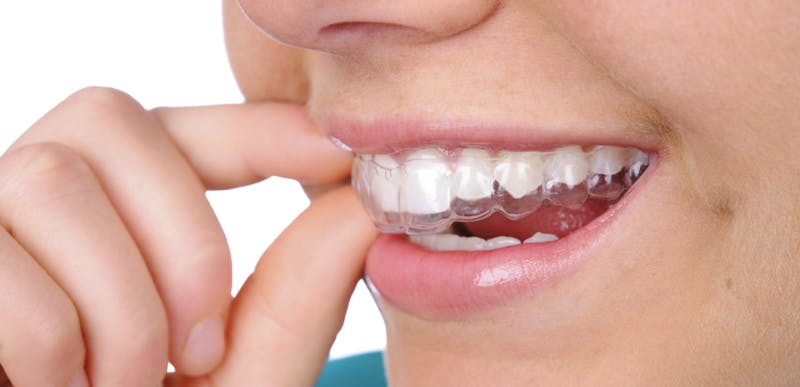
How it works
Aligners work using the same general principle as traditional braces; they apply pressure to the teeth in order to gradually move them into position. They align teeth just as braces do, but using transparent, removable aligners. Aligners only need to be worn for sixteen to twenty hours a day since they need to be removed while eating and brushing. Each aligner is worn for three weeks before changing to the next one. They are changed every two to four weeks, and each new set will be slightly different from the last one. With each new aligner set, your teeth slowly adjust and gradually realign to your desired smile. Sometimes the amount of time you need to wear a specific tray can vary too.
Recovery time
The recovery time depends on the severity of crowding, spacing and the treatment option you choose. On average, aligners usually take a time of about 15 months to achieve the desired results. Your orthodontist will be able to give you an accurate estimate of how long your braces treatment will take.
After treatment
- It is advised to rinse and brush the aligners every night to avoid bacterial build up and discoloration.
- It is important to wear the clear aligners daily for at least 20 hours a day to achieve the desired results.
- Sometimes doctor may recommend retainers. Retainers are necessary because teeth can unfortunately shift back into their pre-treatment position.
- You’ll need to keep up with regular office visits.
Advantages
- Aligners are nearly invisible; most people won’t even notice you are wearing them.
- Clear aligners are ideal for patients with allergies to metals.
- Fewer dental appointments required as traditional braces need to be tightened regularly
- Aligners are much easier to clean and are very comfortable.
- They are more esthetic than traditional braces.
- Unlike metal or ceramic braces, aligners are removable. This makes brushing and flossing an easy task.
- It is a more comfortable and less painful way to move teeth than traditional braces.
- Aligners also help hide existing gaps.
- With aligners you get to see and enjoy the progress along your journey.
Disadvantages
Since aligners are removable they come with minimal risks.
- Clear aligners are limited to certain cases and the amount of movement that can be achieved.
- Because aligners are removable, patients might be tempted to remove them if they experience some discomfort.
- If the patient does not cooperate in actually wearing the aligners, treatment may not work.
- They can be easily lost and costly to replace. Lost clear aligners may result in treatment delay.
Treatable cases
Aligners are typically used for patients who have mild or moderately crowded teeth, or have minor spacing issues. Patients who have severe crowding or spacing problems may need more complex treatment. Aligners can successfully realign or straighten teeth, close mild spaces, treat elongated teeth and tip teeth into better position. They can be used to treat the following conditions:
- Spacing
- Cross bite
- Over bite
- Crowding
- Open bite
- Under bite
Side effects
Because they are removable they have minimal side effects, but like any other medical procedure, teeth alignment does have some side effects.
- Change in the speech: One of the major initial issues for many patient is a slight change in their speech. This generally returns to normal with time.
- Cheek bite: Many patients report biting the inside of their cheeks, resulting in cold sores. When this occurs, it is recommended to rinse the mouth immediately with an anti bacterial wash to prevent further infection.
- During the initial days of using clear aligners, a person is likely to feel some soreness in their jaws as the bone softens and the teeth move.
- In rare cases, the plastic used to create the aligners can cause an allergic reaction.
DISCLAIMER
This web page provides general information and discussions about health, medicine and related subjects. The information and other content provided on this website, or in any linked materials, are not intended and should not be construed as medical advice, nor is the information a substitute for professional medical expertise or treatment.
The content is for information purpose only and is not a medical advice. Qualified doctors have gathered information from reputable sources; however Credence Medicure Corporation is not responsible for errors or omissions in reporting or explanations. No individual should use the information, resources and tools contained herein to self diagnose or self treat any medical condition.
If you or any other person has a medical concern, you should consult with your health care provider or seek other professional medical treatment. Never disregard professional medical advice or delay in seeking it because of something that have read on this blog or in any linked materials. If you think you may have a medical emergency, call your doctor or emergency services immediately.
The opinions and views expressed on this blog and website have no relation to those of any academic, hospital, health practice or other institution. Credence Medicure Corporation gives no assurance or warranty regarding the accuracy, timeliness or applicability of the content.
